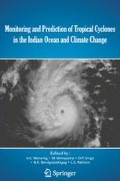Abstract
Early warning system of cyclonic disturbances (depressions and cyclones) involves various aspects including monitoring and prediction of their genesis, intensity and movement. Forecasters essentially require maximum surface wind and central pressure to estimate the intensity of cyclonic disturbances (CDs). Presently genesis, intensity of CDs over North Indian Ocean (NIO) is mainly monitored by Infrared (IR) and visible cloud imageries from geostationary satellites as surface observations over ocean are scanty (IMD, 2003). There is scarcity of direct observations from the surface and upper air over the NIO due to limited number of buoys and ships and absence of aircraft reconnaissance unlike over the North Atlantic Ocean and Northwest Pacific Ocean. Dvorak’s technique (Dvorak, 1975, 1984) is used to determine intensity of CDs using IR and visible cloud pattern taken by Kalpana and INSAT-3A satellites. The Satellite Division of the India Meteorological Department (IMD) is estimating centre positions and intensities of tropical cyclones by the Dvorak method, which uses infrared and visible imagery from Kalpana-1 geostationary meteorological satellite. The technique is subjective and imprecise as high degree of skill is required to recognize cloud patterns.
Access this chapter
Tax calculation will be finalised at checkout
Purchases are for personal use only
Preview
Unable to display preview. Download preview PDF.
References
Bessho, K., Demaria, M. and Knaff, J.A. (2006). Tropical cyclone wind retrieval from Advanced Microwave Sounder Unit(AMSU) application to surface wind analysis. J. Appl. Meteorol., 45: 399-415.
Cecil, D.J. and Zipser, E.J. (1999). Relationship between tropical cyclone intensity and satellite based indicators of inner core convection—85 GHz ice scattering signature and lightening. Mon.Wea.Rev., 103-123.
Dvorak, V.F. (1975). Tropical cyclone intensity analysis and forecasting from satellite imagery. Mon. Wea. Rev., 103: 420-430.
Dvorak, V.F. (1984). Tropical cyclone intensity analysis using satellite data. NOAA Tech. Rep. 11. [Available from NOAA/NESDIS, 5200 Auth Rd., Washington, DC 20333.]
Evans, K.F. and Stephens, A.L. (1993). Microwave remote sensing algorithms for cirrus cloud and precipitation. Dept of Atmospheric Science, Colarado University, 540,198.
Goodberlet, M.A., Swift, C.T. and Wilkerson, J.C. (1989). Remote sensing of ocean surface with special sensor microwave/imager. J. Geophys. Res., 94: 14555-14574.
Hawkins, J.D., Lee, T.F., Turk, J., Sampson, C., Kent, J. and Richardson, K. (2001). Real-time internet distribution of satellite products for tropical cyclone reconnaissance. Bull. Amer. Meteor. Soc., 82: 567-578.
IMD (2003). Cyclone Manual. India Meteorological Department, New Delhi.
Knaff, J.A., Brown, D.P., Courtney, J., Gallina, G.M. and Beven III, J.L. (2010). An evaluation of Dvorak technique–based tropical cyclone intensity estimates. Wea. Forecasting, 25: 1362-1379.
Kummerow, C., Olson, W.S. and Giglow, L. (1996). A simplified scheme for obtaining precipitation and hydrometeor profile from passive microwave sensor. IEEE. Trans, Geosci. Remote Sense., 34: 1213-1232.
Meeks, M.L. and Lilley, A.E. (1963). The microwave spectrum of oxygen in the earth’s atmosphere. J. Geophys. Res., 68: 1683-1703.
RSMC, New Delhi (2010). Report on cyclonic disturbances over north Indian ocean during 2009. IMD, New Delhi.
RSMC, New Delhi (2011). Report on cyclonic disturbances over north Indian ocean during 2010. IMD, New Delhi.
RSMC, New Delhi (2012). Report on cyclonic disturbances over north Indian ocean during 2011. IMD, New Delhi.
Velden, C.S. and Smith, W.L. (1983). Monitoring Tropical cyclone evolution with NOAA satellite microwave observations. J. Climate. Appl. Meteorol., 22: 714- 724.
Velden, C.S., Olson, W.S. and Roth, B.A. (1989). Tropical cyclone center-fixing using DMSP SSM/I data. In: Fourth Conf. on Satellite Meteorology and Oceanography, Amer. Meteor. Soc., San Diego, CA.
Author information
Authors and Affiliations
Corresponding author
Editor information
Editors and Affiliations
Rights and permissions
Copyright information
© 2014 Capital Publishing Company
About this chapter
Cite this chapter
Goyal, S., Mohapatra, M. (2014). Estimation of Centre and Intensity of Tropical Cyclones over the North Indian Ocean Using Microwave Imageries. In: Mohanty, U.C., Mohapatra, M., Singh, O.P., Bandyopadhyay, B.K., Rathore, L.S. (eds) Monitoring and Prediction of Tropical Cyclones in the Indian Ocean and Climate Change. Springer, Dordrecht. https://doi.org/10.1007/978-94-007-7720-0_16
Download citation
DOI: https://doi.org/10.1007/978-94-007-7720-0_16
Publisher Name: Springer, Dordrecht
Print ISBN: 978-94-007-7719-4
Online ISBN: 978-94-007-7720-0
eBook Packages: Earth and Environmental ScienceEarth and Environmental Science (R0)

